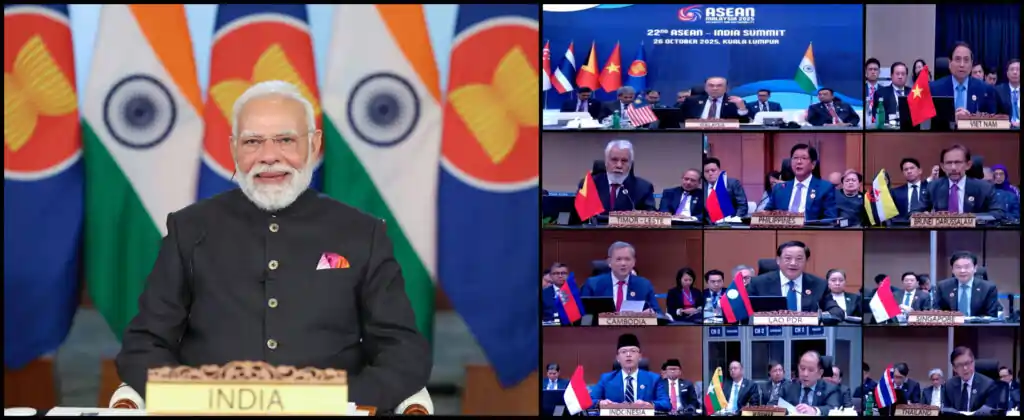New Delhi: Prime Minister Narendra Modi, addressing the 22nd ASEAN-India Summit virtually from New Delhi on October 26, proclaimed the 21st century “the century of India and ASEAN” and designated 2026 as the ASEAN-India Year of Maritime Cooperation. The announcement, delivered under Malaysia’s 2025 ASEAN chairmanship, underscored India’s commitment to ASEAN centrality and the ASEAN Outlook on the Indo-Pacific (AOIP) while unveiling a robust five-year action plan through 2030.
External Affairs Minister S. Jaishankar represented India in person at the Kuala Lumpur gathering, which also served as the East Asia Summit (EAS) platform. The summit welcomed Timor-Leste as ASEAN’s 11th member and reviewed progress in the Comprehensive Strategic Partnership elevated in 2022.

Historical Context and Strategic Imperative
India’s engagement with ASEAN began in 1995 as a dialogue partner, ascending to summit-level ties in 2002. The annual ASEAN-India Summit and EAS have since become pivotal for New Delhi’s Act East Policy. Notably, the Quadrilateral Security Dialogue (Quad) — comprising Australia, India, Japan, and the United States — was revived in 2017 on the summit’s sidelines after a decade-long hiatus.
This year’s proceedings unfolded against heightened Indo-Pacific turbulence: U.S. tariff policies disrupting global trade, Chinese restrictions on critical exports, and persistent maritime disputes. At the EAS, Jaishankar described the environment as “complicated,” critiquing Washington’s selective application of principles in constraining Russia energy trade and Beijing’s challenges in supply-chain reliability and market access.
Modi’s Address: A Blueprint for 2026–2030
Marking his 12th summit participation, Modi congratulated Timor-Leste on its full membership and pledged continued support for its human development. He endorsed the ASEAN Community Vision 2045 and reiterated India’s backing for ASEAN unity and centrality.
Key announcements included:
- Implementation of the ASEAN-India Plan of Action (2026–2030), extending the 10-point agenda from the 2024 Vientiane summit covering tourism, education, digital transformation, health resilience, and climate action.
- Adoption of the ASEAN-India Joint Leaders’ Statement on Sustainable Tourism.
- Designation of 2026 as the ASEAN-India Year of Maritime Cooperation, prioritizing humanitarian assistance and disaster relief (HADR), maritime security, and the blue economy.
- Convening the Second ASEAN-India Defence Ministers’ Meeting and Second ASEAN-India Maritime Exercise to foster operational coordination.
- Training of 400 ASEAN professionals in renewable energy to support the ASEAN Power Grid initiative.
- Extension of Quick Impact Projects to Timor-Leste.
- Establishment of a Centre for Southeast Asian Studies at Nalanda University.
- Hosting the East Asia Summit Maritime Heritage Festival in Lothal, Gujarat, alongside a conference on maritime security cooperation.
Modi emphasized terrorism as a “serious threat” requiring collective action and urged expedited review of the ASEAN-India Trade in Goods Agreement (AITIGA) to unlock economic potential.
Economic Integration and Trade Dynamics
ASEAN constitutes India’s fourth-largest trading partner, accounting for 11 percent of its global trade. However, India’s trade deficit with the bloc surged from $9.66 billion in 2016–17 to $43.57 billion in 2022–23. The AITIGA review aims to streamline customs, reduce non-tariff barriers, and expand services and investment opportunities.
Digital cooperation gained prominence, with India’s Unified Payments Interface (UPI) drawing interest as a model for ASEAN financial modernization. The ASEAN-India Fund for Digital Future, launched in 2024, will support joint initiatives in artificial intelligence, blockchain supply-chain management, and digital health platforms.
| India-ASEAN Trade Snapshot | |
| Global Trade Share | 11% |
| Trade Deficit (2022–23) | $43.57 billion |
| Deficit (2016–17) | $9.66 billion |
| Priority | AITIGA modernization |
Connectivity: Physical and Digital Corridors
Infrastructure projects dominated connectivity discussions. Leaders pushed for completion of the India-Myanmar-Thailand Trilateral Highway and the Kaladan Multi-Modal Transit Project to integrate India’s northeastern states into regional trade networks. Alignment with ASEAN’s Master Plan on Connectivity (MPAC) 2025 through the “Connecting the Connectivities” framework was highlighted.
Digital infrastructure received equal emphasis, encompassing broadband networks, submarine cables, and satellite systems. The inaugural ASEAN-India Track 1 Cyber Policy Dialogue established mechanisms to counter cyber threats to critical infrastructure.
Maritime Security and Geopolitical Balancing
The 2026 Maritime Cooperation Year will rest on four pillars: maritime security and safety, blue economy and sustainability, HADR, and connectivity. Shared concerns over freedom of navigation, illegal fishing, and South China Sea tensions underpin this focus.
India’s participation in ASEAN-led forums — the ASEAN Regional Forum (ARF), ASEAN Defence Ministers’ Meeting Plus (ADMM-Plus), and EAS — signals institutional commitment. For ASEAN, navigating U.S.-China rivalry, India offers a democratic partner upholding non-interference and ASEAN centrality. The Malacca Strait, through which 80 percent of India’s energy imports pass, underscores Southeast Asia’s strategic value.
Modi’s Absence: A Diplomatic Question Mark
Despite the substantive agenda, Modi’s second consecutive in-person absence — he also skipped the 2022 summit — drew scrutiny. Malaysian Prime Minister Anwar Ibrahim conveyed Modi’s regrets citing domestic festivities, but the explanation strained credibility given months of prior scheduling.
Speculation ranged from Bihar Assembly election campaigns to U.S. President Donald Trump’s attendance amid India-U.S. trade frictions. Others pointed to bilateral strains following Malaysia’s diplomatic support for Pakistan during India’s Operation Sindoor and a recent visit by Pakistan’s prime minister to Kuala Lumpur.
While Jaishankar delivered India’s positions effectively, critics argued the physical void undercut New Delhi’s messaging, especially as global leaders demonstrated commitment through presence.
Looking Ahead: From Vision to Delivery
The summit concluded with ASEAN leaders appreciating India’s enduring partnership. Malaysia’s Anwar described the relationship as rooted in “friendship, trust, and shared interests.” The Philippines will assume the 2025–2026 ASEAN chairmanship.
Success hinges on three deliverables: rapid AITIGA finalization, accelerated connectivity projects, and tangible benefits under the Act East Policy. With a combined GDP exceeding $3 trillion and a young demographic, the India-ASEAN corridor holds immense potential for supply-chain diversification and sustainable growth.
As Indo-Pacific rivalries intensify, the partnership offers a model of cooperative autonomy — reinforcing ASEAN centrality while advancing mutual security and prosperity.
FAQs
1. What is the ASEAN-India Year of Maritime Cooperation announced for 2026?
2026 has been designated the ASEAN-India Year of Maritime Cooperation, focusing on four pillars: maritime security and safety, blue economy and sustainability, humanitarian assistance and disaster relief (HADR), and connectivity infrastructure. Initiatives include the Second ASEAN-India Maritime Exercise and a maritime heritage festival in Lothal, Gujarat.
2. Why is the review of the ASEAN-India Trade in Goods Agreement (AITIGA) urgent?
India’s trade deficit with ASEAN has risen sharply from $9.66 billion in 2016–17 to $43.57 billion in 2022–23. The AITIGA review aims to simplify customs, reduce non-tariff barriers, and expand opportunities in services and investment to balance trade and unlock the partnership’s full economic potential.
3. Which new country joined ASEAN at the 2025 summit?
Timor-Leste officially became ASEAN’s 11th member at the Kuala Lumpur summit on October 26, 2025. Prime Minister Modi welcomed its delegation and extended India’s support for its human development and integration through Quick Impact Projects.
4. Why did Prime Minister Modi address the summit virtually instead of attending in person?
Modi cited domestic festivities as the reason, conveyed through Malaysian Prime Minister Anwar Ibrahim. However, speculation includes Bihar election campaigning, U.S.-India trade tensions amid President Trump’s presence, and lingering bilateral friction over Malaysia’s support for Pakistan during Operation Sindoor.
5. What is the ASEAN-India Plan of Action (2026–2030) and what does it cover?
Endorsed at the summit, the Plan of Action (2026–2030) builds on the 2024 Vientiane 10-point agenda. It includes timelines for cooperation in sustainable tourism, digital transformation, renewable energy training (400 professionals), defence ministers’ meetings, cyber policy dialogue, and emerging technologies such as semiconductors and critical minerals.

